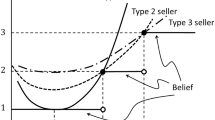Abstract
We investigate the effect of limiting the number of reserve prices on the revenue in a probabilistic single item auction. In the model considered, bidders compete for an impression drawn from a known distribution of possible types. The auction mechanism sets up to \(\ell \) reserve prices, and each impression type is assigned the highest reserve price lower than the valuation of some bidder for it. The bidder proposing the highest bid for an arriving impression gets it provided his bid is at least the corresponding reserve price, and pays the maximum between the reserve price and the second highest bid. Since the number of impression types may be huge, we consider the revenue \(R_{\ell }\) that can be ensured using only \(\ell \) reserve prices. Our main results are tight lower bounds on \(R_{\ell }\) for the cases where the impressions are drawn from the uniform or a general probability distribution.

Similar content being viewed by others
Notes
Real life ad exchanges have access to a vast log history, which allows for a good estimate of the bidders’ values based on historical bids and other, less direct, means such as the conversion rate associated with the bidder and impression at hand.
An instance of an auction consists of the possible impression types, as well as the probability associated with each type. The exact type of the impression that arrives in practice is not considered part of the instance. A formal definition of the auctions we consider is given in Sect. 2.
If the choice of reserve prices is based on historical bids, it might be beneficial for a bidder to lie in the current auction round, and probably lose some value, in order to affect the reserve prices set in future auctions. We leave such complex (and probably unpractical) plots outside our scope.
Technically, when removing impressions from an auction, we get an invalid auction where the total probability of all impression types is less than 1. We assume throughout this section that if \(\sum _{i = n - n' + 1}^{n} p_i < 1\), then with probability \(1 - \sum _{i = n - n' + 1}^{n} p_i\) no impression arrives, and the revenue is 0.
References
Athey, S., Cramton, P., Ingraham, A.: Setting the upset price in British Columbia timber auctions. MDI Report for British Columbia Ministry of Forests (2002)
Cremer, J., McLean, R.P.: Full extraction of the surplus in bayesian and dominant strategy auctions. Econometrica 56(6), 1247–1257 (1988)
Emek, Y., Feldman, M., Gamzu, I., Leme, R.P., Tennenholtz, M.: Signaling schemes for revenue maximization. ACM Trans. Econ. Comput. 2(2), 5 (2014)
Ghosh, A., Nazerzadeh, H., Sundararajan, M.: Computing optimal bundles for sponsored search. In: Conference on Web and Internet Economics, pp. 576–583. Springer, Berlin, Heidelberg (2007)
Levin, J., Milgrom, P.: Online advertising: heterogeneity and conflation in market design. Am. Econ. Rev. 100(2), 603–607 (2010)
Maskin, E., Riley, J.: Optimal auctions with risk averse buyers. Econometrica 52(6), 1473–1518 (1984)
McAfee, R.P., McMillan, J., Reny, P.J.: Extracting the surplus in a common value auction. Econometrica 57(6), 1451–1459 (1989)
McAfee, R.P., Vincent, D.R.: Updating the reserve price in common value auctions. Am. Econ. Rev. Pap. Proc. 82(2), 512–518 (1992)
Miltersen, P.B., Sheffet, O.: Send mixed signals: earn more, work less. In: ACM Conference on Electronic Commerce, pp. 234–247. ACM, New York (2012)
Muthukrishnan, S.: Ad exchanges: research issues. In: Conference on Web and Internet Economics, pp. 1–12. Springer, Berlin, Heidelberg (2009)
Myerson, R.: Optimal auction design. Math. Oper. Res. 6(1), 58–73 (1981)
Ostrovsky, M., Schwarz, M.: Reserve prices in internet advertising auctions: a field experiment. In: ACM Conference on Electronic Commerce, pp. 59–60. ACM, New York (2011)
Palfrey, T.: Bundling decisions by a multiproduct monopolist with incomplete information. Econometrica 51(2), 463–483 (1983)
Tang, P., Sandholm, T.: Mixed-bundling auctions with reserve prices. In: International Conference on Autonomous Agents and Multiagent Systems, pp. 729–736. International Foundation for Autonomous Agents and Multiagent Systems, Richland, SC (2012)
Walsh, W.E., Parkes, D.C., Sandholm, T., Boutilier, C.: Computing reserve prices and identifying the value distribution in real-world auctions with market disruptions. In: Conference on Artificial Intelligence, pp. 1499–1502. AAAI Press (2008)
Author information
Authors and Affiliations
Corresponding author
Rights and permissions
About this article
Cite this article
Alon, N., Feldman, M. & Tennenholtz, M. Revenue and Reserve Prices in a Probabilistic Single Item Auction. Algorithmica 77, 1–15 (2017). https://doi.org/10.1007/s00453-015-0055-1
Received:
Accepted:
Published:
Issue Date:
DOI: https://doi.org/10.1007/s00453-015-0055-1



